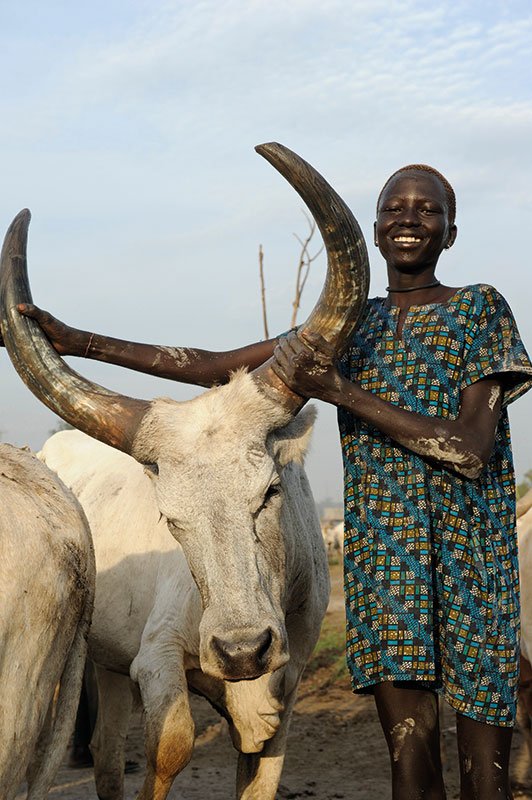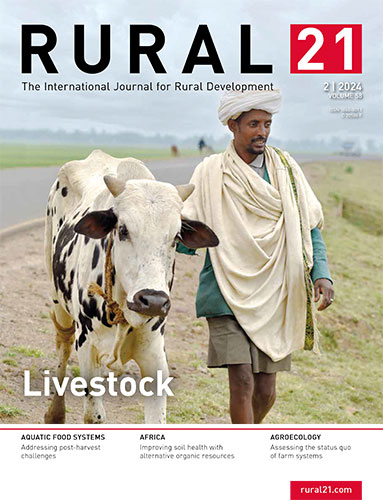 Download this article in magazine layout
Download this article in magazine layout
- Share this article
- Subscribe to our newsletter
Effects of sedentarisation policies
Sedentarisation refers to transitioning from nomadic or transhumant mobility to a more settled lifestyle. This has been a topic of interest in West Africa due to its impact on agricultural production, food security and poverty. Recently, West African governments have promoted several policies of livestock herd sedentarisation for several reasons. One of the underlying justifications is that both the colonial administration and the African governments regarded the pastoralist way of life as conflicting with farming and incompatible with the standard of civilised society. In a sadly recurring story, national governments often perceive the lifestyle of small foraging populations as impoverished, with cultural values detrimental to their welfare, leading to resettlement in new communities. However, it’s essential to recognise that this process can have significant consequences, including the privatisation of resources and soil fertility decline in certain regions. The disappearance of specialised single agricultural activity farms and the emergence of integrated farms are also associated with sedentarisation. Overall, the motivations behind these policies are complex and multifaceted, involving economic, social and cultural considerations.
The case of Benin
In northern Benin, cattle farms face feed scarcity and conflicts in the management of pastoral resources, including land. This led to the adoption of the new pastoral code (Law n° 2018-20 of April 23rd, 2019) regulating this activity and opting for the sedentarisation of livestock. In 2021, Benin’s Office of the High Commissioner for the Sedentarisation of Livestock Breeders began implementing a sedentarisation policy to “modernise” traditional transhumance practices among herders.
The policy aims to provide a “unique model of alternatives to transhumance” while gradually implementing sedentarisation. Transhumant pastoralists have settled in Benin, partly due to droughts in the 1970s and as a coping mechanism in response to changing political economy. The government explicitly supports this sedentarisation agenda, which is largely embraced by pastoralist Fulani communities. In Benin, sedentarisation policies have been implemented to address farmer-herder conflicts. Farmer-herder conflict and transhumance in Northern Benin are deep-rooted in tensions between communities because of agricultural and animal breeding activities practised in the same areas. Historically, farmers and herders in West Africa had symbiotic relationships. However, changes in the political economy of pastoralism, for example land reforms (ownership, access and use), agricultural development including mechanisation and land grabbing from herders, disrupted this relationship. The rapid demographic growth, urbanisation and industrialisation led to increased demand for food and agricultural produce. This expansion of agricultural land limited grazing and transhumance areas, threatening pastoral livelihoods. Addressing farmer-herder tensions and rethinking present policies is crucial. The current strategy seeks pastoralist sedentarisation but lacks a clear evidence-based approach. Benin’s sedentarisation policy aims to transform traditional practices while recognising the complexity of Fulbe’s livelihoods. However, addressing underlying issues and promoting evidence-based policies remain essential for sustainable conflict resolution.
What are the effects of these policies?
The effects of sedentarisation policies on herders and their communities can be both positive and negative. The positive effects include:
- improvement of livelihoods where sedentarisation can lead to better access to services – such as healthcare and education – and economic opportunities;
- sustainable resource management, as controlled grazing may reduce environmental degradation and overuse of pastureland;
- conflict mitigation, as reduced mobility can decrease farmer-herder clashes in specific areas.
However, the policies can have some negative effects, such as:
- loss of traditional livelihoods – herders may lose their nomadic lifestyle, cultural practices, and social identity;
- land tenure challenges – implementing sedentarisation requires addressing land tenure issues, which can be complex;
- resource constraints – fixed locations may strain already scarce resources like water and grazing land.
The balance between these effects is important for successful implementation of sedentarisation policies.
How can conflicts between herders and farmers be resolved?
Meanwhile, policy-makers can take several steps to address the negative effects of sedentarisation on herders and their communities. These include:
- land tenure reforms such as securing land rights by ensuring that herders have secure land tenure, allowing them to access and manage land effectively and community-based approaches by involving the local communities in land management decisions to prevent conflicts;
- livelihood diversification through skills training by providing training in alternative livelihoods (e.g. agroforestry) to compensate for lost income and value-added activities by encouraging value-added activities related to livestock (e.g. dairy processing);
- infrastructure development: through establishing of water infrastructure (wells, boreholes) to support sedentary herders and through improved access to healthcare and education services;
- social services and cultural preservation by promoting cultural events, festivals, and traditional practices and strengthening social networks to mitigate isolation;
- conflict resolution mechanisms through ease of dialogues between farmers and herders to resolve disputes and by establishing clear legal frameworks for conflict resolution.
Lessons learnt from Benin
In Benin, new pastoral legislation has led to a reduction in transhumance areas for semi-mobile livestock farming and a densification of herds in the territories. It has resulted in an increased pressure on communal rangelands and therefore, in feed insufficiency in the different livestock farming systems, especially in the rainy season with difficult access to land. The expansion of agricultural areas, together with the corresponding cultivation techniques, considerably reduce grazing areas and give rise to antagonisms between breeders and farmers in the regions.
With the current dynamics in North Benin, significant flows of animals have been observed towards forest areas and low-pressure territories, which explains the decrease of more than 15 per cent in the cattle herd between 2013 and 2021 in this area. The application of the new provisions recommended by the law on the regulation of transhumance remains complicated for mobile breeders. The latter perceive these changes in animals mainly through the drop in milk production and significant weight loss. The sedentarisation programme (ProSer) in Benin intends to recommend new exploitation strategies based on the cultivation of forage species and the regulation of internal mobility. Despite these efforts, forage production is struggling to develop on farms and pasture degradation is increasing, exacerbating the conflict situation. But land availability and access to seeds constitute the real obstacles to fodder intensification. Particular attention must be paid to the mechanisms for removing these barriers for the success of the policy of sedentarisation of livestock farming.
Rodrigue V. Cao Diogo is a crop-livestock agronomist and an associate professor based in Benin. He has 15 years of experience in the crop-livestock production sector and issues related to sustainable food systems, livestock mobility and sustainable production, livestock sedentarisation and sustainable land use. He works at the Integrated Production Systems Innovation Lab & Sustainable Land Management Faculty of Agronomy of the University of Parakou, Benin. Contact: rodrigue.diogo@fa-up.bj
Allogbénou S. Frimence Toussou is a PhD student at the doctoral school of agricultural and water sciences, University of Parakou. He holds a master degree in livestock science and is currently working on exploring the potential of sustainable land use scenarios for rangeland biodiversity management, ecosystem services and livestock production in northern Benin.
Saliou Adedigba holds a PhD degree in zootechnics and production systems at the doctoral school of agricultural and water sciences, University of Parakou. He has expertise in sustainable intensification of livestock family farms and has worked on sustainable improvement of milk productivity in cattle family farms through the promotion of fodder intensification in northern Benin.
References:
Broca, Sumiter. (2002). Food Insecurity, Poverty and Agriculture: A Concept Paper.
Brottem, L. (2021). The Growing Complexity of Farmer- Herder Conflict in West and Central Africa. Africa Security Brief: A Publication of the Africa Center for Strategic Studies, 39, 1–8.
Claire K. & Laura S. (2024), Don’t Call It Farmer-Herder Conflict - The SAIS Review of International Affairs (jhu.edu).
De Bruijne, K. (2021). Laws of Attraction Northern Benin and risk of violent extremist spillover. In CRU Report. What drives high levels of communal violence in northern Benin? | Laws of Attraction (clingendael.org).
De Haan, L., van Driel, A., & Kruithof, A. (1990). From symbiosis to polarization?:Peasants and pastoralists in northern Benin. Indian Geographical Journal, 65(1), 51-65.
Diogo, R.V.C., Dossa L. H., Vanvanhossou S.F.U., Abdoulaye B.D., Dosseh K.H., Houinato M., et al., 2021a. Farmers’ and herders’ perceptions on rangeland management in two agroecological zones of Benin. Land, 10 (4): 425. https://doi.org/10.3390/land10040425.
Djohy, G. (2017). Pastoralism and Socio-technological Transformations in Northern Benin-Fulani Innovations in Pastoral Migration, Livelihood Diversification and Professional Association. Göttingen Series in Social and Cultural Anthropology. Volume 10, Universitätsverlag Göttingen. 365p.
Dossouhoui, G. I., Yemadje, P. L., Diogo, R. V. C., Balarabe, O., & Tittonell, P. (2023). “Sedentarisation” of transhumant pastoralists results in privatization of resources and soil fertility decline in West Africa's cotton belt. Frontiers in Sustainable Food Systems, 7, 1120315. https://doi.org/10.3389/fsufs.2023.1120315.
Gassner, A., Harris, D., Mausch, K., Terheggen, A., Lopes, C., Finlayson, R., & Dobie, P. (2019). Poverty eradication and food security through agriculture in Africa: Rethinking objectives and entry points. Outlook on Agriculture. https://doi.org/10.1177/0030727019888513.
Okai, M. (1997). Agricultural Production, Food Security and Poverty in West Africa. In: Asenso-Okyere, W.K., Benneh, G., Tims, W. (eds) Sustainable Food Security in West Africa. Springer, Boston, MA. https://doi.org/10.1007/978-1-4615-6105-7_2.
PRASG2CG (2019). Loi no 2018-20 du 23 Avril 2019 portant code pastoral en République du Bénin. 22p.




